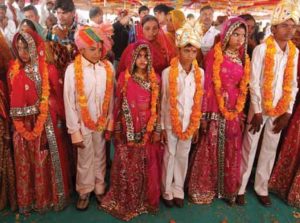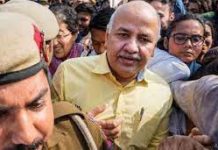 Police in western Assam’s Barpeta district could rescue 16-year-old Amina Khatoon (name changed) hours before her marriage on September 6 only because she had called the Childline helpline (1098). Amina, a Class XII student knew that marriage before 18 is unhealthy and illegal made her seek the help of police as she did not want to get married so early and wanted to continue her study.
Police in western Assam’s Barpeta district could rescue 16-year-old Amina Khatoon (name changed) hours before her marriage on September 6 only because she had called the Childline helpline (1098). Amina, a Class XII student knew that marriage before 18 is unhealthy and illegal made her seek the help of police as she did not want to get married so early and wanted to continue her study.
“My father is illiterate and is not aware that child marriage is bad. They wanted me to get married as they had got an educated boy working in a good company. But I want to complete graduation and try for a government job before getting married,” Amina had told Child Line officials in Barpeta, hours after she was rescued and the 28-year-old boy with whom her parents had fixed marriage was arrested.
That education of the girls helps in checking India’s serious problem of child marriage has been highlighted in the India Child Marriage and Teenage Pregnancy report prepared by National Commission for Protection of Child Rights (NCPCR) that found India’s child marriage between 15 to 19 years old girls came down from 27 per cent to 11.9 per cent between 2005-06 to 2015- 16. The rate of child marriage among 20 to 24 years old was found to be 26.8 per cent.
The report says higher the level of education, lower the change of child marriage. “Women’s educational level is found to be negatively associated with the prevalence of child marriage for both 15-19 years and 20-24 years age groups. For example, the prevalence of child marriage among women with no education amongst 15 to 19 years and 20 to 24 years age groups is 30.8 per cent and 49.3 per cent respectively. On the other hand the prevalence of child marriage is substantially lower among the women with higher education for both age groups (2.4 per cent and 3.9 per cent respectively),” says the report prepared by the NCPCR based on analysis of the National Family Health Survey 3 (NFHS) in 2005-06 and NFHS 4 of 2015 and16.
Although the survey showed declining trend of the problem of child marriage entrenched mainly among India’s illiterate sections, child marriage rate is higher than the national average of 11.6 per cent in at least 12 states and Union Territory seems to have emerged as a worry for those who see the country to be a child-marriage free country.
West Bengal tops the rate list of 12 states having child marriage problem higher than the national average with 25.6 per cent followed by Tripura (21.6), Bihar (19.7), Jharkhand (17.8), Dadar and Nagar Haveli (17.5), Assam (16.6), Andhra Pradesh (16.6), Rajasthan (16.2), Gujarat (13.1), Telangana (12.9), Maharashtra (12.1) and Arunachal Pradesh (12.1).
Poverty was found to be a contributing factor as it was evident from the findings that a girl from a poor family was more likely to get married at a younger age than a girl from a wealthier family. “The state-level analysis also highlights that child marriage among girls is so entrenched in certain social groups that a substantial proportion of girls from middle and top wealth tercile households are also reported to be married before 18,” said the report.
The report found that completion of secondary education played a significant role in delaying the age at marriage. “Findings show the completion rate of secondary schooling is considerably higher amongst unmarried girls aged 15-19 years in almost all states. Making secondary schooling a fundamental right and ensuring girls from poor households are provided safe learning environments as well as residential secondary schools for remote areas may be considered as necessary steps to prevent early marriage in Indian states. In Bihar, a completion rate of secondary education amongst girls who married before age 18 is only 51 per cent, followed by 54 per cent in Delhi and Rajasthan (57 per cent).
The report said there was a strong relationship between girl child marriage and household wealth index as a girl from a poor family was found to be more likely being married at a younger age than a girl from a wealthier family. “The state-level analysis also highlights that child marriage amongst girls is so entrenched in certain social groups that a substantial proportion of girls from middle and top wealth tercile households are also reported to be married before age 18,” it said. In Assam, child marriage was found to be higher among two sections: the Muslims living in the riverine areas and those in the tea gardens, mainly due to low literacy poverty and role of religious leaders who allow such illegal practice.
The report found that 15 per cent child marriage happened among Scheduled Tribes and 13 per cent among Scheduled Castes.
“However, when we analysed child marriages amongst the top 10 states with the highest prevalence of child marriage we found that this phenomenon is occurring across caste groups. For instance In Arunachal Pradesh, 72 per cent of the sample aged between 15-19 years who had child marriages belong to Scheduled Tribes while 38 per cent of the Other Castes girls in Maharashtra reported the highest percentage of married girls before 18. Furthermore, while Bihar, Gujarat and Telangana report a very high prevalence of child marriage amongst OBC girls, West Bengal has the highest prevalence of child marriage amongst SC girls,” it said.
The report also identified 100 districts having the highest prevalence of child marriage with Murshidabad in West Bengal leading the tally with 39.9 per cent child marriage among 15-19 years old girls. Gandhinagar in Gujarat came second with 39.3 per cent followed by Bhilwara in Rajasthan (36.4 per cent), Shrawasti (36.3 per cent) in Uttar Pradesh, Birbhum (35.2 per cent) in West Bengal, Khagaria (34.4 per cent) in Bihar, Goalpara (33.9 per cent) in Assam, Deoghar (32.7 per cent) and Giridih (32.2 per cent) in Jharkhand. “Analysis of top 100 districts based on the high prevalence of child marriage reveals that 14 states have these high prevalence districts. Bihar has the maximum number of districts with high prevalence (20), followed by West Bengal (14), Jharkhand (11), Rajasthan (10), Assam (9), Maharashtra (9), Madhya Pradesh (8), Gujarat (5), Tripura (4), Andhra Pradesh (3), Uttar Pradesh (3), Telangana (2), Karnataka (1) and Odisha (1).
Adverse impacts:
The report said analysis of NFHS-4 revealed that amongst the married girls aged between 15 to 19 years, 31.5 per cent of the sample girls in this age group were found to have babies. “It is important to note that almost a quarter of the married girls in the 15-16 years age group had at least one baby while more than a quarter of the married teenage girls had at least one child at age 17 while 31 per cent had a child by age 18,” it said.
Further analysis of the number of children born to teenage mothers revealed that 27.3 per cent of married teenage girls had given birth to one child while 4.2 per cent of married girls had given birth to two or more children. At least 12 states had more than 40 per cent of these girls having at least one child or more. Goa, Mizoram and Meghalaya topped the list with 64 per cent, 61 per cent and 53 per cent teenage pregnancies among the early married girls.
Solutions at question
Child rights activists campaigning against the serious problem of child marriage says quality education for girls could have made a major change on further reducing child marriage rate in the country. “Apart from education, we must provide skill development courses to young girls and action against religious leaders who mislead poor and illiterate people in the villages with the misinformation that child marriage is allowed by religious scriptures. At the same time we must have a strong political will to move the agenda of child marriage prevention,” said Chiranjeeb Kakoty, the chair of the National Action and Coordination Group for Ending Violence Against Children (NACG-EVAC), India. Kakoty based in Guwahati also leads Adolescent and Child Rights Network, a forum of nearly 25 NGOs in Assam.
Chairperson of NCPCR, the apex child rights body, Stuti Kacker said in the report, “We hope this report will trigger the required policy decisions at the national and state levels and support formulation of action plans at the district levels focused on preventing child marriage and teenage pregnancies.”
LETTERS@TEHELKA.COM













